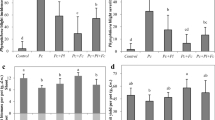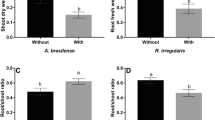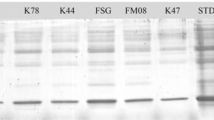Abstract
The compatibility of two biological inoculants, Trichoderma harzianum, a mycoparasitic biological control fungus and Piriformospora indica, a root colonizing plant-growth promoting endophytic fungus was evaluated using tissue cultured black pepper plantlets. We report, for the first time, the ability of P. indica to colonize black pepper, a perennial climber. T. harzianum inhibited the growth of P. indica in an in vitro dual culture plate assay. Simultaneous inoculation with both biological inoculants of tissue cultured black pepper plantlets negatively influenced root colonization by P. indica. However, when P. indica was applied initially followed 30 days later by T. harzianum, there was increased root colonization by the root endophyte P. indica and beneficial effects were found on the growth of the black pepper plants. The present study also showed that the efficacy of inoculation of the two fungal biological agents can be increased by sequential application of P. indica at the hardening stage followed by T. harzianum during transplanting into a soil-sand mixture.

Similar content being viewed by others
References
Anandaraj M, Sarma YR (1994) Effect of vesicular arbuscular mycrorrhizae on rooting of black pepper. J Spices Aromatic Crops 3:39–42
Anandraj M, Sarma YR (1995) Diseases of black pepper (Piper nigrum) and their management. J Spices Aromatic Crops 4:17–23
Anith KN, Manomohandas TP (2001) Combined application of Trichoderama and Alcaligenes sp. strain AMB 8 for controlling nursery rot (Phytophthora capsici) of black pepper (Piper nigrum). Indian Phytopath 54:335–339
Anith KN, Roystephen (2009) Alginate encapsulated delivery of rhizobacteria for better root colonization and plant growth promotion of black pepper in the nursery. J Plantation Crops 37:94–96
Anith KN, Radhakrishnan NV, Manomohandas TP (2002) Management of nursery wilt of black pepper (Piper nigrum L.) with antagonistic bacteria. Curr Sci 83:561–562
Anith KN, Radhakrishnan NV, Manomohandas TP (2003) Screening of antagonistic bacteria for biological control of nursery wilt of black pepper (Piper nigrum). Microbiol Res 158:91–97
Chet I, Harman GE, Baker R (1981) Trichoderma hamatum: Its hyphal interactions with Rhizoctonia solani and Phythium spp. Microb Ecol 7:29–38
Deshmukh S, Kogel K-H (2007) Piriformospora indica protects barley from root rot caused by Fusarium graminearum. J Plant Dis Prot 114:263–268
Deshmukh S, Hückelhoven R, Schäfer P, Imani J, Sharma M, Weiss M, Waller F, Kogel K-H (2006) The root endophytic fungus Piriformospora indica requires host cell death for proliferation during mutualistic symbiosis with barley. Proc Natl Acad Sci USA 103:18450–18457
Divya S (2002) Management of foot rot of black pepper (Piper nigrum L.) with mycoinoculant enriched Vermicompost. M.Sc. (Ag.) thesis, Kerala Agricultural University, Thrissur, p 110
Douds DD, Schenck NC (1990) Relationship of colonization and sporulation by VA mycorrhizal fungi to plant nutrient and carbohydrate contents. New Phytol 116:621–627
Druege U, Baltruschat H, Franken P (2007) Piriformospora indica promotes adventitious root formation in cuttings. Sci Hortic 112:422–426
Fakhro A, Andrade-Linares DR, von Bargen S, Bandte M, Büttner C, Grosch R, Schwarz D, Franken P (2010) Impact of Piriformospora indica on tomato growth and on interaction with fungal and viral pathogens. Mycorrhiza 20:191–200
Joseph L, Nazeem PA, Thampi MS, Philip S, Balachandran M (1996) in vitro techniques for mass multiplication of black pepper (Piper nigrum L.) and ex vitro performance of the plantlets. J Plantation Crops 24:511–516
Kumar V, Sahai V, Bisaria VS (2011) High-density spore production of Piriformospora indica, a plant-growth promoting endophyte, by optimization of nutritional and cultural parameters. Bioresource Technol 102:3169–3175
Kumari R, Krishnan H, Bhoon YK, Varma A (2003) Colonization of cruciferous plants by Piriformospora indica. Curr Sci 85:1672–1674
Lorito M, Harman GE, Hayes CK, Broadway RM, Tronsmo A, Woo SL, Di Pietro A (1993) Chitinolytic enzymes produced by Trichoderma harzianum: antifungal activity of purified endochitinase and chitobiosidase. Phytopathology 83:302–307
Manjunath A, Bagyaraj DJ (1982) Vesicular arbuscular mycorrhizae in three plantation crops and cultivars of field bean. Curr Sci 51:707–708
Oelmüller R, Sherameti I, Tripathi S, Varma A (2009) Piriformospora indica, a cultivable root endophyte with multiple biotechnological applications. Symbiosis 49:1–17
Rai M, Acharya D, Singh A, Varma A (2001) Positive growth response of the medicinal plants Spilathes calva and Withania somnifera to inoculation by Piriformospora indica in a field trial. Mycorrhiza 11:123–128
Sahay NS, Varma A (1999) Piriformospora indica: a new biological hardening tool for micropropagated plants. FEMS Microbiol Lett 181:297–302
Satheesan J, Narayanan AK, Sakunthala M (2011) Induction by root colonization by Piriformospora indica leads to enhanced asiaticoside production in Centella asiatica. Mycorrhiza doi:10:1007/s00572-011-0394-y (in press)
Serfling A, Wirsel SGR, Lind V, Deising HB (2007) Performance of the biocontrol fungus Piriformospora indica on wheat under greenhouse and field conditions. Phytopathology 97:523–531
Sherameti I, Tripathi S, Varma A, Oelmüller R (2008) The root colonizing endophyte Piriformospora indica confers drought tolerance in Arabidopsis by stimulating the expression of drought stress-related genes in leaves. Mol Plant Microbe Interact 21:799–807
Varma A, Verma S, Sudha SNS, Butehorn B, Franken P (1999) Piriformospora indica, a cultivable plant growth promoting root endophyte with similarities to arbuscular mycorrhizal fungi. Appl Environ Microbiol 65:2741–2744
Verma S, Varma A, Rexer KH, Hassel A, Kost G, Sarbhoy A, Bisen P, Butehorn B, Franken P (1998) Piriformospora indica gen et. sp. nov., a new root colonizing fungus. Mycologia 90:896–903
Waller F, Achatz B, Baltruschat H, Becker K, Fischer M, Heier T, Hu R, Neumann C, von Wettstein D, Franken P, Kogel K-H (2005) The endophytic fungus Piriformospora indica reprograms barley to salt-stress tolerance, disease resistance, and higher yield. Proc Natl Acad Sci USA 102:3386–13391
Acknowledgements
The authors are grateful to Dr. Ajit Varma for providing the culture of Piriformospora indica for the work. The financial assistance for the work was provided by Kerala State Council for Science, Technology and Environment (KSCSTE), Government of Kerala.
Author information
Authors and Affiliations
Corresponding author
Rights and permissions
About this article
Cite this article
Anith, K.N., Faseela, K.M., Archana, P.A. et al. Compatibility of Piriformospora indica and Trichoderma harzianum as dual inoculants in black pepper (Piper nigrum L.). Symbiosis 55, 11–17 (2011). https://doi.org/10.1007/s13199-011-0143-1
Received:
Accepted:
Published:
Issue Date:
DOI: https://doi.org/10.1007/s13199-011-0143-1




